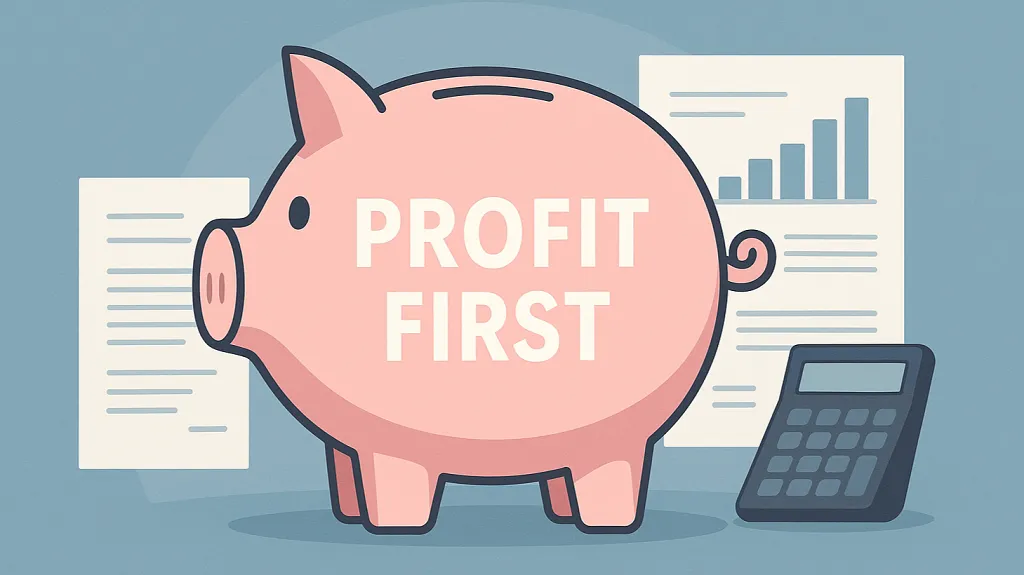Financial management is one of the toughest and most critical skills for small business owners. For decades, traditional accounting methods have been the gold standard, but newer strategies like the Profit First Method are changing the way business owners think about money management.
If you’ve been wondering about the Profit First vs traditional method pros and cons, you’re not alone. In this guide, we’ll dig deep into both approaches, show how they compare, and help you figure out what works best for your business.
What Is the Traditional Accounting Method?
The traditional accounting method follows a formula most business owners know by heart:
Sales - Expenses = ProfitIn this setup, profit is what’s left over after paying for expenses. It’s a reactive approach that places profit last, often leading business owners to spend whatever money they have available and hope there’s something left at the end.
Key Characteristics:
- Focused on generating sales first.
- Expenses are prioritized to maintain operations.
- Profit is treated as a residual.
Benefits of Traditional Accounting:
- Standardized financial reporting: Generates financial statements like income statements, balance sheets, and cash flow reports aligned with GAAP (Generally Accepted Accounting Principles).
- Bank and investor friendly: These reports are required for securing loans, lines of credit, or attracting investors.
- Regulatory compliance: Necessary for tax filings and audits.
Drawbacks:
- Profit becomes an afterthought: Business owners often find themselves with little to no profit after covering expenses.
- Cash flow blind spots: Profits on paper don’t always translate to cash in the bank.
- Encourages reactive management: Spending decisions are often made without a proactive plan for profit.
For growing businesses looking to scale and attract outside funding, traditional accounting remains a must. However, it doesn’t always help owners develop better cash flow habits or improve day-to-day financial discipline.
What Is the Profit First Method?
The Profit First Method, introduced by Mike Michalowicz in his book Profit First, flips the traditional model on its head:
Sales - Profit = ExpensesThe Profit First formula forces businesses to prioritize profit first, then operate the business within the limits of what’s left over. It’s not just a formula. It’s a cash management system that divides business income into different “buckets” or bank accounts.
Typical Account Structure in Profit First:
- Income Account: All revenue is deposited here.
- Profit Account: A set percentage is transferred here first.
- Owner’s Pay Account: Ensures the owner pays themselves consistently.
- Tax Account: Prepares for tax obligations.
- Operating Expenses Account: Funds remaining are used to cover operational costs.
Benefits of the Profit First Method:
- Profitability becomes automatic: By taking profit first, owners build financial stability from the start.
- Better cash management: With multiple accounts, business owners can see exactly how much is available for expenses, taxes, and profits.
- Behavioral finance advantage: Forces better financial discipline by limiting spending.
Drawbacks:
- Not GAAP-compliant alone: Businesses still need to maintain traditional financial records for taxes and external reporting.
- Mindset shift required: Business owners must adjust from thinking “spend and hope” to “save and plan.”
- More complex setup: Setting up and managing multiple bank accounts requires effort and consistent maintenance.
For small business owners struggling with cash flow or profit margins, Profit First can create immediate improvements in financial health and peace of mind.
Profit First vs Traditional Method: A Detailed Comparison
| Feature | Traditional Accounting | Profit First Method |
|---|---|---|
| Primary Focus | Maximize sales and manage expenses | Prioritize profit from each sale |
| Profit Timing | After expenses | First allocation |
| Cash Flow Management | Indirect, based on statements | Direct, based on cash in bank |
| Ease of Implementation | Simple | Requires multiple bank accounts |
| Regulatory Compliance | Fully GAAP-compliant | Supplementary, not a replacement for GAAP |
| Behavioral Impact | Spend-then-save mindset | Save-then-spend mindset |
| Financial Reporting | Standardized, universally accepted | Internal use; not suitable for official reporting |
| Ideal For | Businesses needing loans/investment | Businesses focused on profitability and cash flow discipline |
Example: Applying Each Method
Imagine Sarah, who owns a small marketing agency.
Traditional Accounting:
Sarah focuses on bringing in clients and generating as much revenue as possible. At the end of the month, she pays her team, covers overhead, and then checks if there’s any profit left. Some months there is, but other months, despite high revenues, cash is tight.
Profit First Method:
Sarah sets up separate bank accounts. Every time a client pays, 10% of the deposit goes straight to her Profit Account, 40% to Owner’s Pay, 15% to Taxes, and the remaining 35% to Operating Expenses. She notices that by limiting her operating budget, she makes smarter hiring decisions and negotiates better deals with vendors. Most importantly, she gets paid consistently and builds real profit reserves.
Profit First vs Traditional Method: Pros and Cons
Traditional Method Pros:
- Simpler setup.
- Provides a broad financial picture.
- Required for taxes, loans, and investors.
Traditional Method Cons:
- Profit often disappears.
- Cash flow can be unpredictable.
- Encourages higher spending when revenues increase.
Profit First Method Pros:
- Profit is guaranteed with every sale.
- Encourages disciplined, lean operations.
- Reduces cash flow anxiety.
Profit First Method Cons:
- Complex to set up and maintain.
- Requires business owner mindset shift.
- Not enough for tax or investor reporting alone.
When to Choose Each Method
| Situation | Recommended Method |
|---|---|
| You’re applying for loans or investments. | Traditional Accounting |
| You want better daily cash management. | Profit First Method |
| You’re scaling rapidly and need investor trust. | Traditional Accounting |
| You struggle with consistent profitability or cash flow. | Profit First Method |
| You want long-term growth and stable cash flow. | Hybrid Approach (Both) |
Common Pitfalls to Avoid
- Neglecting GAAP Compliance: Even if you use Profit First for cash management, you still need proper accounting for taxes and financial reporting.
- Overcomplicating the System: Start simple: 4-5 accounts are plenty at the beginning. Some businesses open too many accounts and create unnecessary complexity.
- Ignoring Industry Nuances: Businesses with highly seasonal income or razor-thin margins may need to adjust their percentages carefully to avoid cash shortages.
- Treating Profit First as “Set and Forget”: Profit allocations should be reviewed quarterly. Businesses grow and change. So should your percentages.
FAQ: Profit First vs Traditional Method
Q: Can I use Profit First without multiple bank accounts?
A: It’s possible to track allocations manually, but the separation of money is key to the psychology behind Profit First. Physically separating funds helps avoid the temptation to spend what should be reserved.
Q: Is Profit First GAAP-compliant?
A: No. Profit First is a cash management system, not a replacement for standard accounting. You’ll still need traditional financial statements for taxes, lenders, and compliance.
Q: How much should I allocate to profit?
A: Profit First suggests starting with 1% if your business is tight on cash. Gradually increase it as you adjust. Most mature businesses using Profit First aim for 5-15% profit allocation depending on the industry.
Q: What if my margins are too tight to set aside profit?
A: That’s a red flag. Tight margins often mean pricing needs adjustment, or expenses are too high. Profit First forces you to confront these issues head-on.
Q: Can I combine both methods?
A: Absolutely. Many businesses use Profit First for internal cash management and traditional accounting for external reporting. This hybrid approach gives you the best of both worlds.
Final Verdict: Which One Works Best?
The choice between Profit First vs traditional method comes down to your business needs and goals.
- If you need formal financial statements for taxes, investors, or banks, traditional accounting is non-negotiable.
- If you struggle with cash flow or profitability, Profit First can bring structure and discipline to your finances.
For many small business owners, the best solution is using both:
- Traditional accounting for reporting and compliance.
- Profit First accounting for cash flow management and everyday financial discipline.
This hybrid approach ensures your business is both compliant and cash-healthy, giving you the best chance at long-term success. Download our Profit First hybrid accounting checklist here.


